Gynecomastia
Wake Plastic Surgery proudly serves Cary, Raleigh, and the surrounding areas.
Overdevelopment of male breast tissue is a concern for many men. Although the problem can be caused by medications, tumors, and hormonal imbalance, most cases are idiopathic (no known cause). Gynecomastia is considered a cosmetic concern in almost all cases, but it can still have serious psychological consequences. Surgical reduction of the chest wall tissue can help restore a sense of normalcy and self esteem.
Gynecomastia Highlights
-

- BMI of 32
and below
-

- 1 Week
out of work
-

- 4-6 Week
Recovery Period
-

- Care Credit Financing
6 months, 24 months
& 36 months
-

- Starting Cost
$7,000 - $9,500
Why choose Wake Plastic Surgery?
Although the treatment for gynecomastia is relatively straightforward, there is a fine art to getting excellent results. Taking too much tissue away can leave a patient with a deficit or indention on the chest which is much more difficult to correct than to avoid in the first place. Leaving too much tissue behind can be frustrating for patients and leads to repeat operations that can be prevented. Our technique that includes both liposuction with power assisted liposuction and direct excision minimizes the need for revision procedures.
Our Gynecomastia ResultsWhat are the different presentations of gynecomastia?
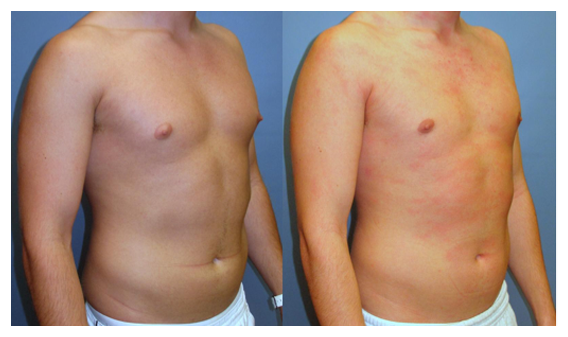
Mild gynecomastia treated with direct excision
Mild
In mild cases, the excess tissue directly behind the nipple is just enough to cause a coning of the areolae. This is often accentuated with changes in temperature or emotion. Direct excision of the glandular tissue eliminates the problem. Failure to direct excision the abnormal tissue very often leads to recurrence and reoperation.
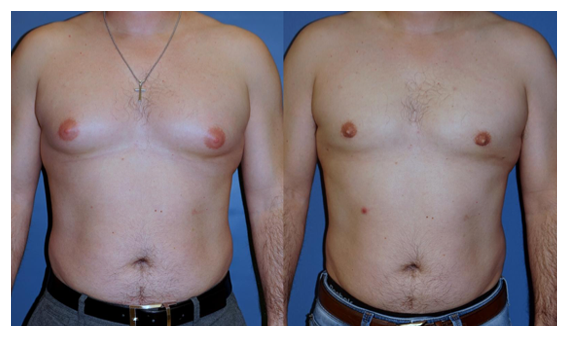
Moderate volume gynecomastia treated with liposuction and direct excision
Moderate
Gynecomastia patients typically have an increase in both fibrofatty and glandular breast tissue. The excess tissue directly behind the nipple typically causes the areolae to become spread out and widened. Removal of the tissue allows the areolae to “shrink” back to normal diameter and have a more masculine appearance. Treatment with both direct excision and liposuction is usually required.
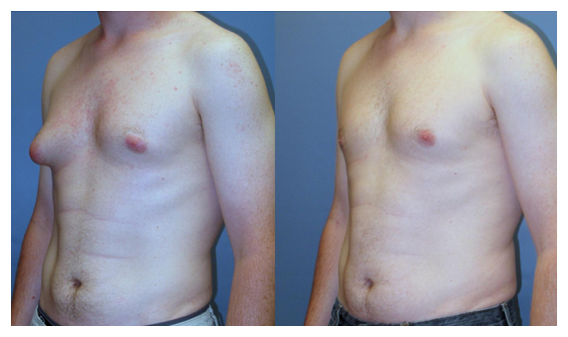
Severe right sided case treated with excision and liposuction
Severe
In severe cases, the breast tissue becomes feminized. Surgical correction usually requires both liposuction and direct excision of the abnormal breastplate tissue. The skin will retract in most cases without the need for traditional breast lift scars. Although, there are cases in which skin excision is necessary.
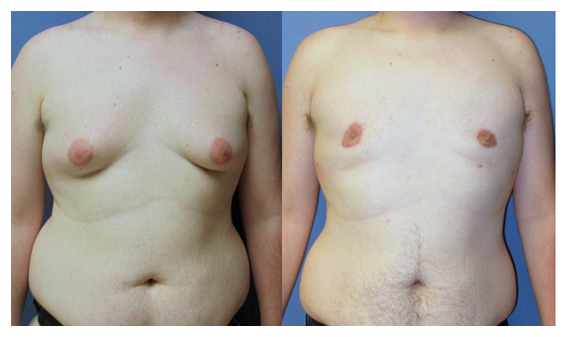
Moderately severe pseudogynecomastia treated with excision and a “donut” mastopexy
Pseudogynecomastia
The classification of pseudogynecomastia is somewhat confusing. The term would indicate that in such cases, there really is not true gynecomastia. But, this is usually not the case. Dr. Stoeckel uses the term to describe cases in which obesity or significant weight loss contributes greatly to the condition. These severe cases consist of both excess breast tissue and significant excess skin. A breast lift procedure is typically required. In moderately severe cases, removal of the skin in a “donut” around the areolae yields the best result and least amount of scarring.
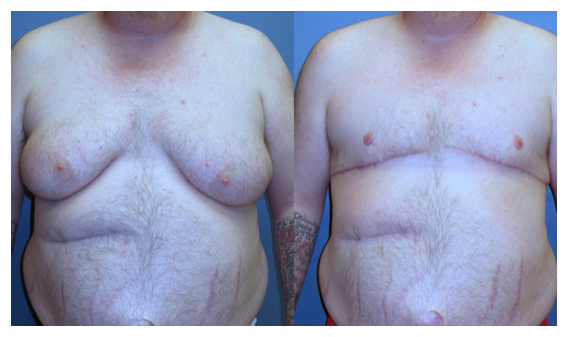
Extreme gynecomastia treating with an amputation technique and skin grafting of the nipple and areolae.
Extreme
In extreme cases, treatment requires a true mastectomy. The excess skin and breast tissue is removed together in a large ellipse resulting in a large horizontal scar along the base of the chest. The nipple and areolae are replaced as a skin graft. The scars are typically much better tolerated than the abnormal breast size and shape in these patients.
Who are good candidates for the procedure?
The best candidates are patients who are healthy and are at a stable weight. Non-smokers have much lower risks than smokers. As mentioned above, the most common cause of gynecomastia is unknown. But patients that have a known cause should have those conditions treated before pursuing breast reduction surgery.
How bad is the scarring?
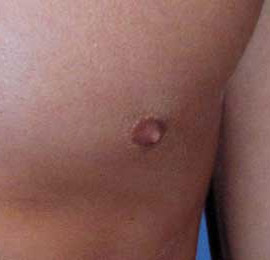
The scars from a typical reduction in which the only incision is along the lower arc of the areola are almost imperceptible. This is by far the most common procedure performed.
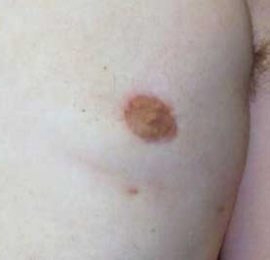
Donut mastopexy scars are not quite as elegant and have a tendency to widen over time, but are still well tolerated. A locking purse-string suture helps prevent scar widening.
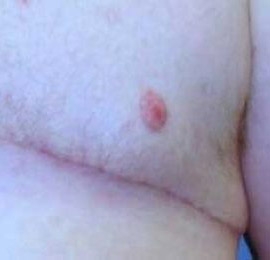
The worst scars are obviously when an amputation technique is required, but the improvement in shape and form far outweigh the negatives of scarring for these patients.
That being said, we have a wide variety of treatments at the MedSpa at Wake Plastic Surgery that can help reduce the appearance of scars. We offer BBL laser, ProFractional laser, and Virtue RF as treatments that can aid in improving the appearance of stubborn scarring. All of Dr. Stoeckel’s and Dr. Barry’s surgical patients are eligible for a complimentary consultation at our MedSpa to discuss these aesthetic options and more.
How is the typical procedure performed?
Most patients will require a deep sedation anesthesia. Liposuction is completed using Power Assisted Liposuction (PAL) technology. This will remove much of the unwanted fatty tissue and some of the unwanted breast tissue. But it almost always leaves the dense breast plate tissue which requires surgical excision. A small incision is then made in the lower arc of the areola and the breast plate tissue removed. The skin incision is closed and steri strips applied. The entire procedure typically takes about 1-1.5 hours to complete.
When can I return to work or the gym?
Keeping the heart rate and blood pressure normal for the first week after surgery is important to reduce the risk of unnecessary bruising or bleeding. After the first week, you will be able to return to all core and lower body exercise activities. Upper body specific exercises such as pushups, pullups, bench press, etc. should be avoided for about 4-6 weeks. Most patients can return to a desk or office job in as little as 2-3 days. But if your job requires heavy lifting or aggressive upper body movements, you may be out for 4-6 weeks.
What causes gynecomastia?
There are rare medical conditions, medications, and herbal supplements that have been associated with gynecomastia. But the vast majority of patients have idiopathic breast enlargement, or no known cause. The underlying issue is thought to be either an imbalance in testosterone and estrogen hormone levels or in the sensitivity of receptors on the breast tissue. About 70% of males develop some level of gynecomastia during adolescence, but most of them see normalization of the tissues as the hormone levels equilibrate. For those that don’t, gynecomastia reduction surgery is the gold standard for treatment.
Schedule A Consultation